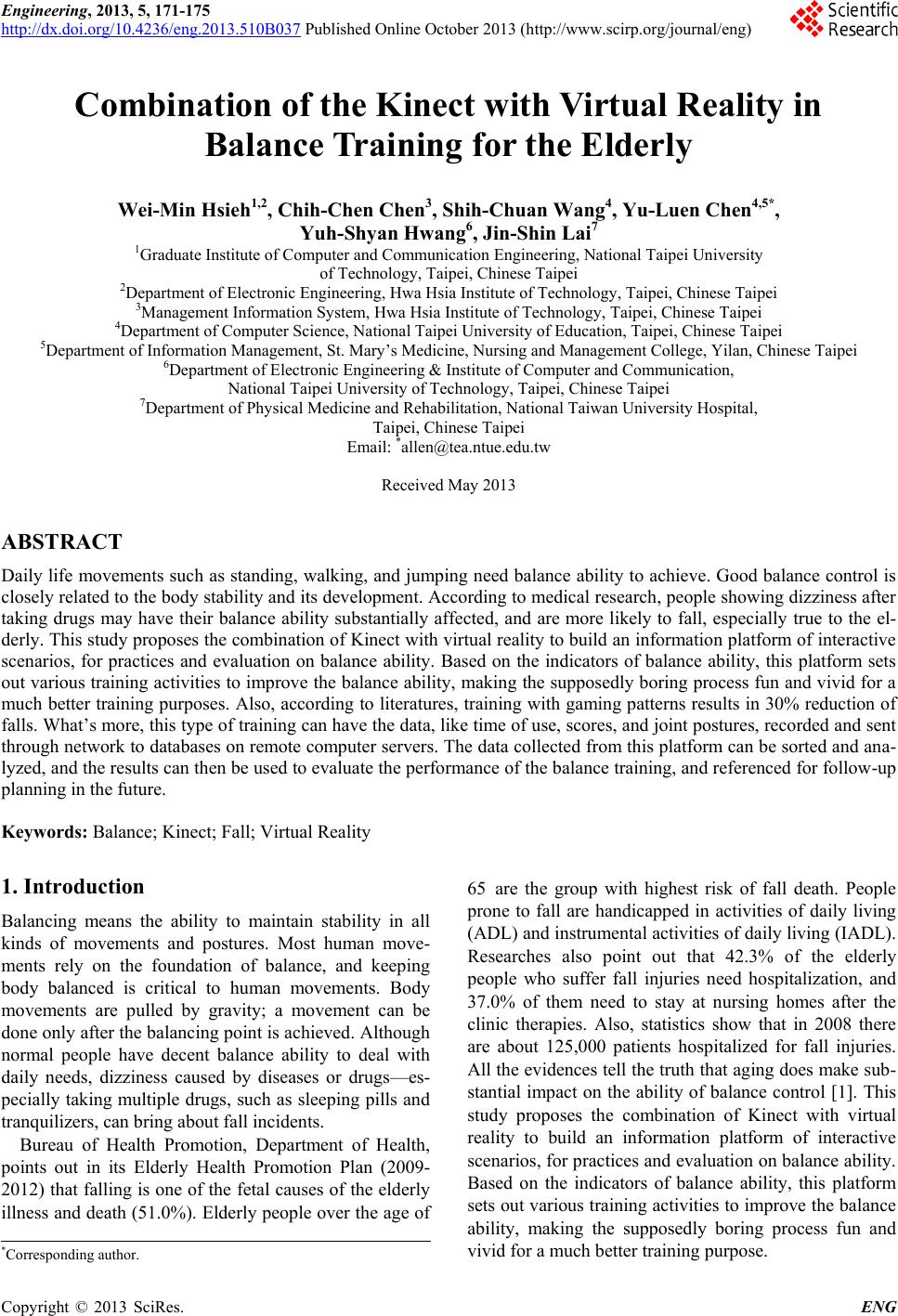
Engineering, 2013, 5, 171-175
http://dx.doi.org/10.4236/eng.2013.510B037 Published Online October 2013 (http://www.scirp.org/journal/eng)
Copyright © 2013 SciRes. ENG
Combination of the Kinect with Virtual Reality in
Balance Training for the Elderly
Wei-Min Hsieh1,2, Chih-Chen Chen3, Shih-Chuan Wang4, Yu-Luen Chen4,5*,
Yuh-Shyan Hwang6, Jin-Shin Lai7
1Graduate Institute of Computer and Communication Engineering, National Taipei University
of Technology, Taipei, Chinese Taipei
2Department of Electronic Engineering, Hwa Hsia Institute of Technology, Taipei, Chinese Taipei
3Management Information System, Hwa Hsia Institute of Technology, Taipei, Chinese Taipei
4Department of Computer Science, National Taipei University of Education, Taipei, Chinese Taipei
5Department of Information Management, St. Mary ’s Medicine, Nursing and Management College, Yilan, Chinese Taipei
6Department of Electronic Engineering & Institute of Computer and Communication,
National Taipei University of Technology, Taipei, Chinese Taipei
7Department of Physical Medicine and Rehabilitation, National Taiwan University Hospital,
Taipei, Chinese Taipei
Email: *allen@tea.ntue.edu.tw
Received May 2013
ABSTRACT
Daily life movements such as standing, walking, and jumping need balance ability to achieve. Good balance control is
closely related to the body stability and its development. According to medical research, people showing dizziness after
taking drugs may have their balance ability substantially affected, and are more likely to fall, especially true to the el-
derly. This study proposes the combination of Kinect with vir tual reality to build an information platform of interactive
scenarios, for practices and evaluation on balance ability. Based on the indicators of balance ability, this platform sets
out various training activities to improve the balance ability, making the supposedly boring process fun and vivid for a
much better training purposes. Also, according to literatures, training with gaming patterns results in 30% reduction of
falls. What’s more, this type of training can have the data, like time of use, scores, and joint postures, recorded and sent
through network to databases on remote computer servers. The data collected from this platform can be sorted and an a-
lyzed, and the results can then be used to evaluate the performance of the balance training, and referenced for follow-up
planning in the future.
Keywords: Balance; Kinect; Fall; Virtual Reality
1. Introduction
Balancing means the ability to maintain stability in all
kinds of movements and postures. Most human move-
ments rely on the foundation of balance, and keeping
body balanced is critical to human movements. Body
movements are pulled by gravity; a movement can be
done only after the balancing point is achieved. Although
normal people have decent balance ability to deal with
daily needs, dizziness caused by diseases or drugs—es-
pecially taking multiple drugs, such as sleeping pills and
tranquilizers, can bring about fall incidents.
Bureau of Health Promotion, Department of Health,
points out in its Elderly Health Promotion Plan (2009-
2012) that falling is one of the fetal causes of the elderly
illness and death (51.0%). Elderly people over the age of
65 are the group with highest risk of fall death. People
prone to fall are handicapped in activities of daily living
(ADL) and instrumental activities o f daily livin g (IADL).
Researches also point out that 42.3% of the elderly
people who suffer fall injuries need hospitalization, and
37.0% of them need to stay at nursing homes after the
clinic therapies. Also, statistics show that in 2008 there
are about 125,000 patients hospitalized for fall injuries.
All the evidences tell the tru th that aging does make sub -
stantial impact on the ability of balance control [1]. This
study proposes the combination of Kinect with virtual
reality to build an information platform of interactive
scenarios, for practices and evaluation on balance ability.
Based on the indicators of balance ability, this platform
sets out various training activities to improve the balance
ability, making the supposedly boring process fun and
vivid for a much better training purpose.
*Corresponding a uthor.